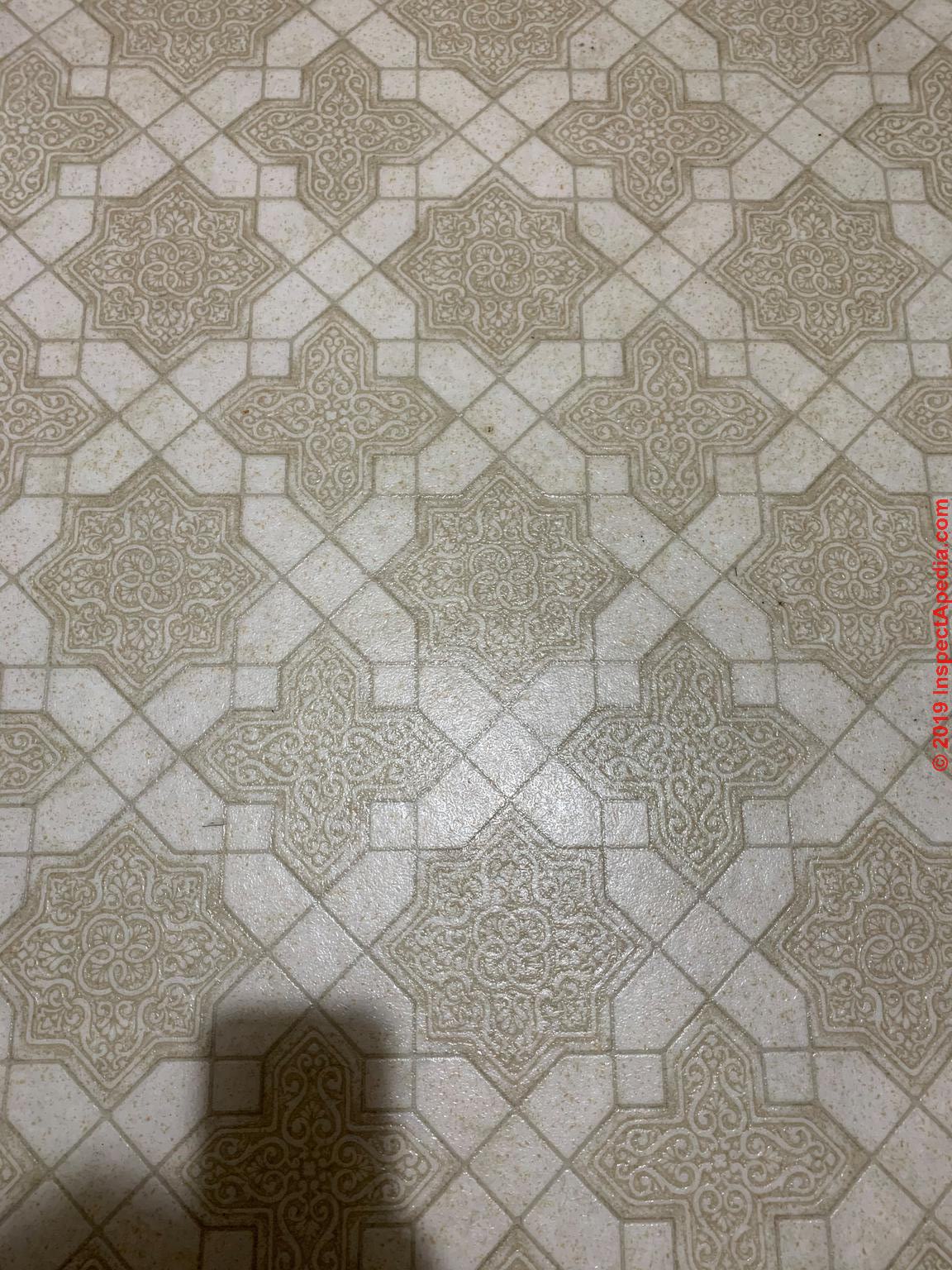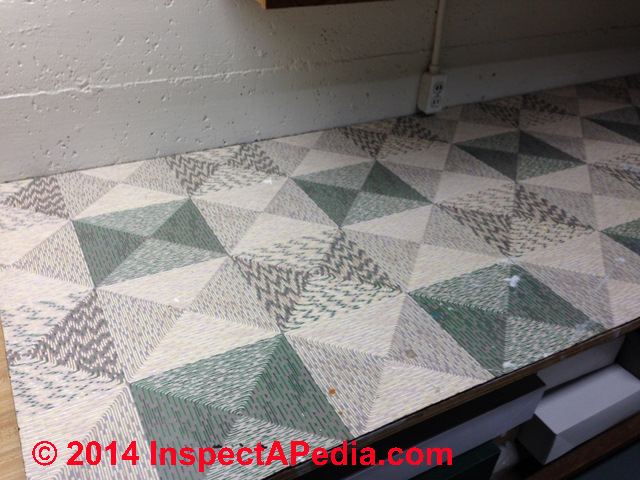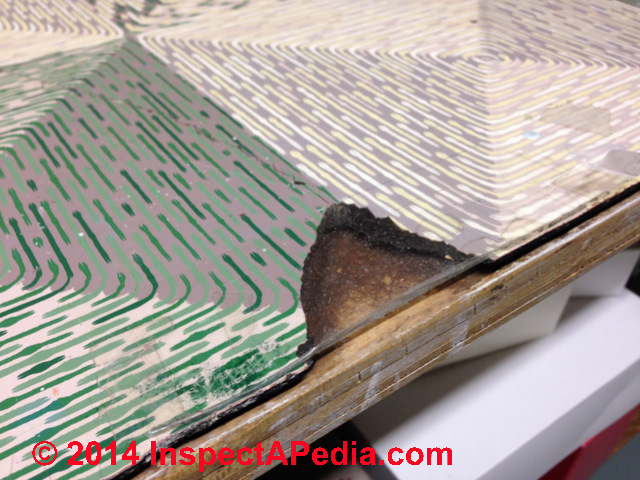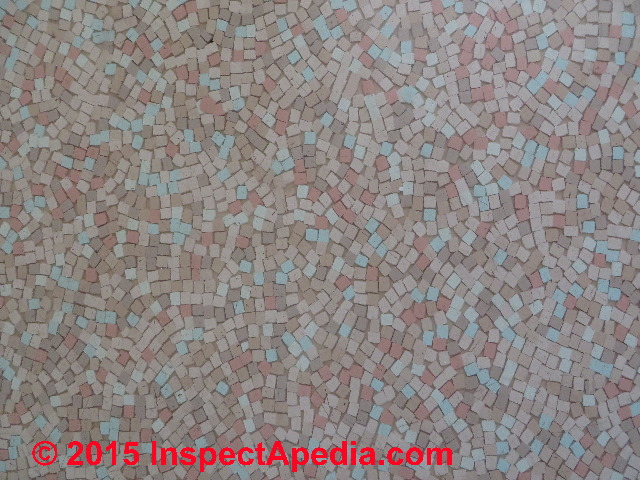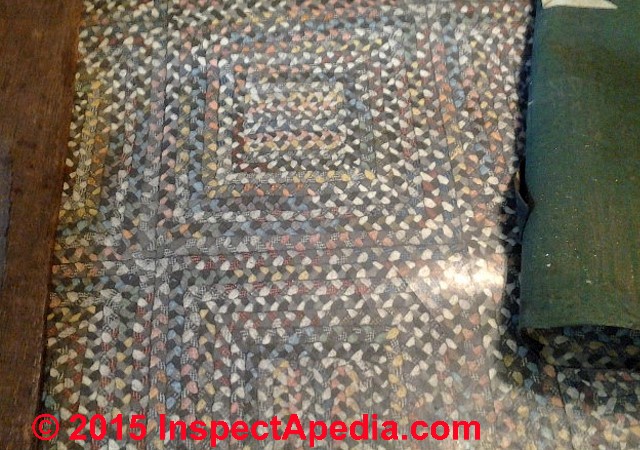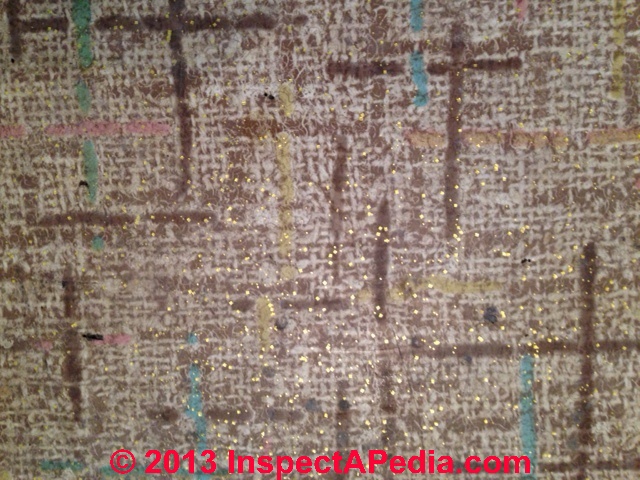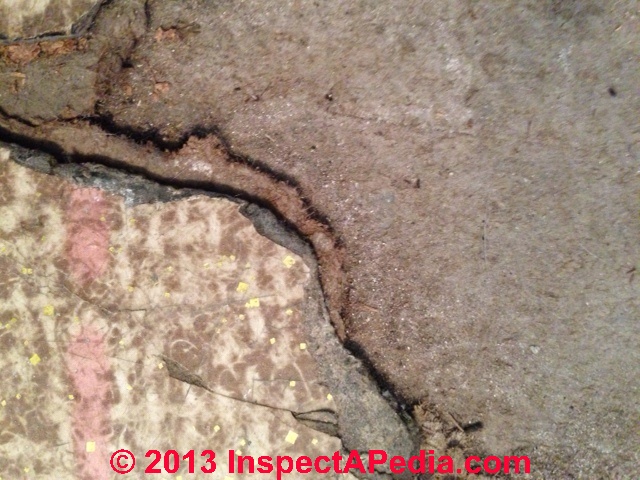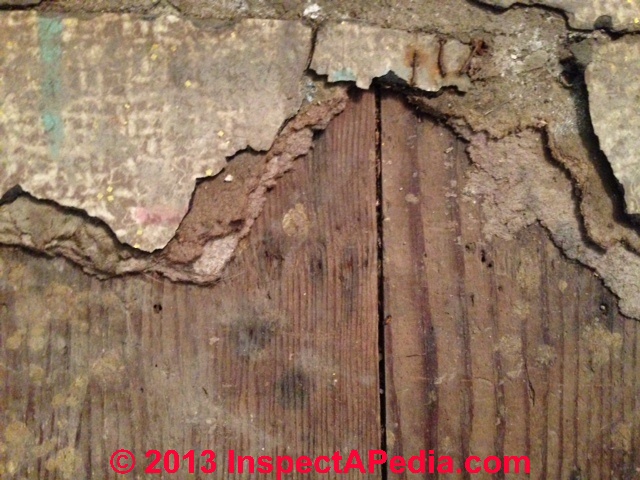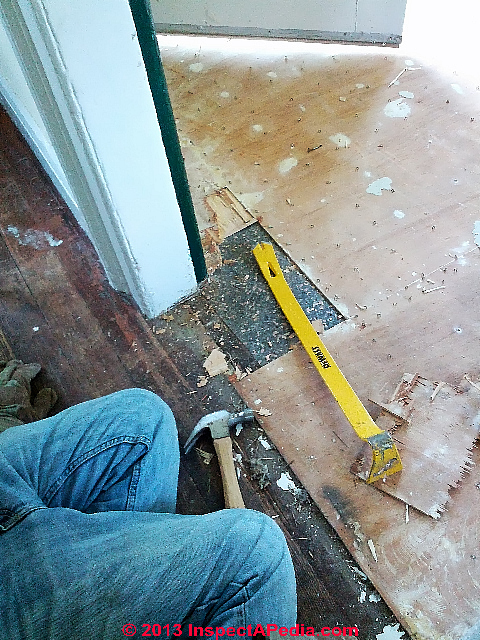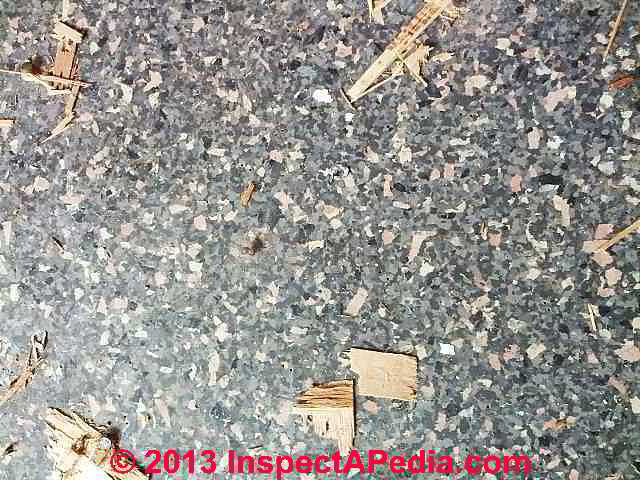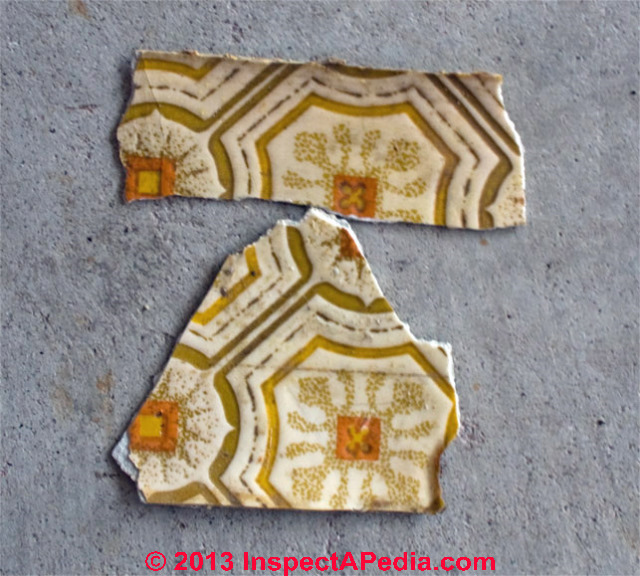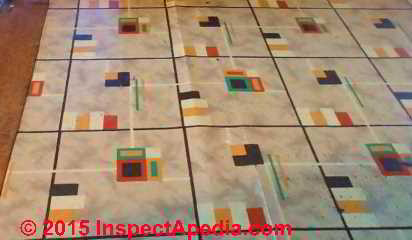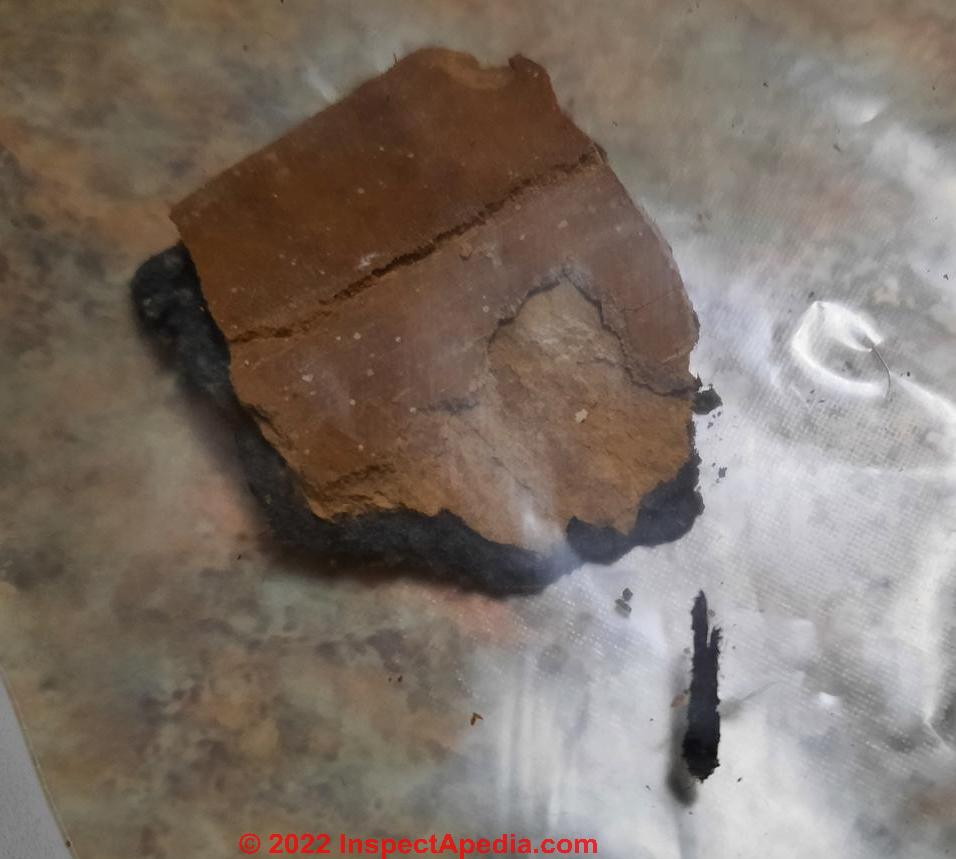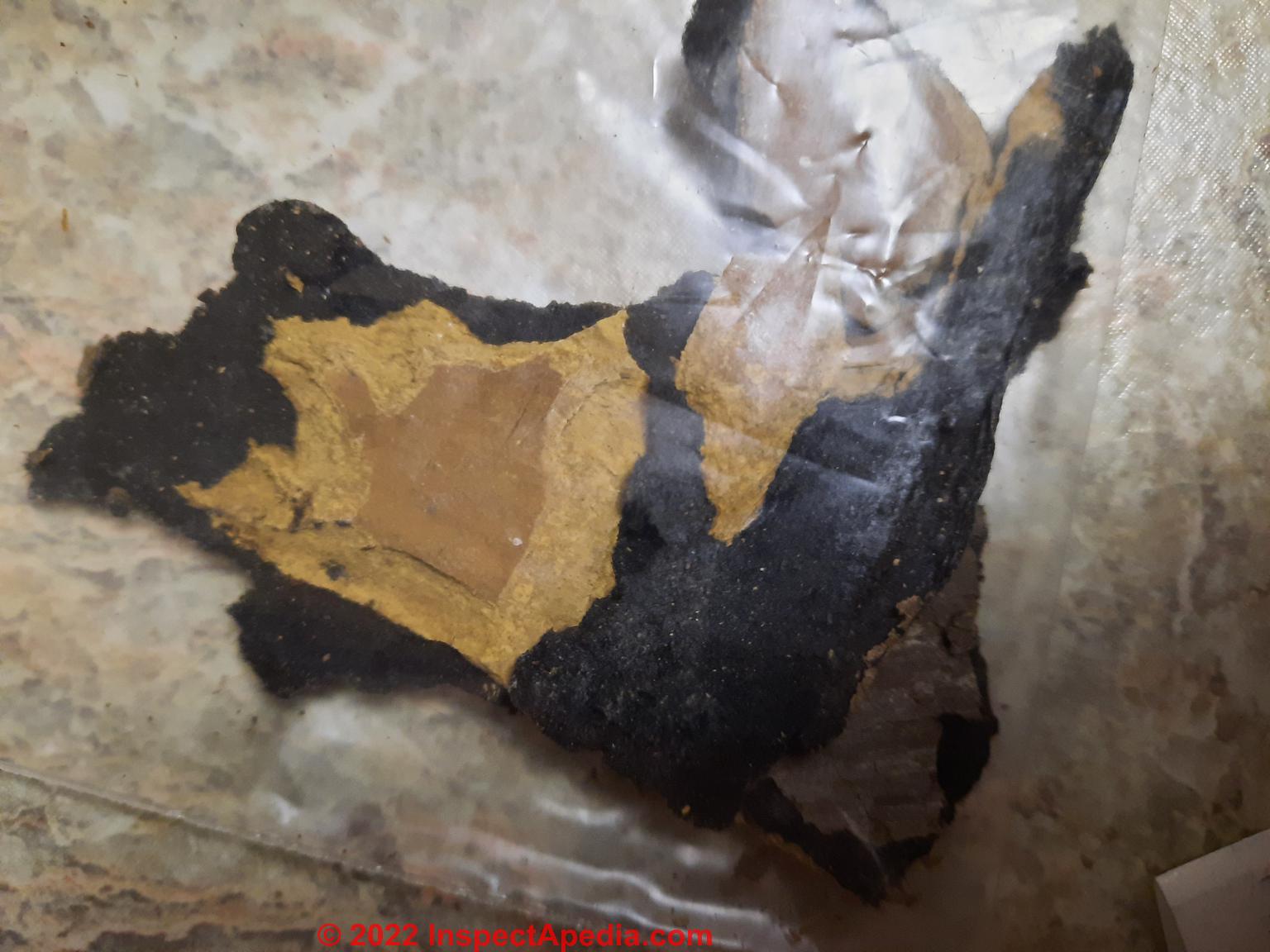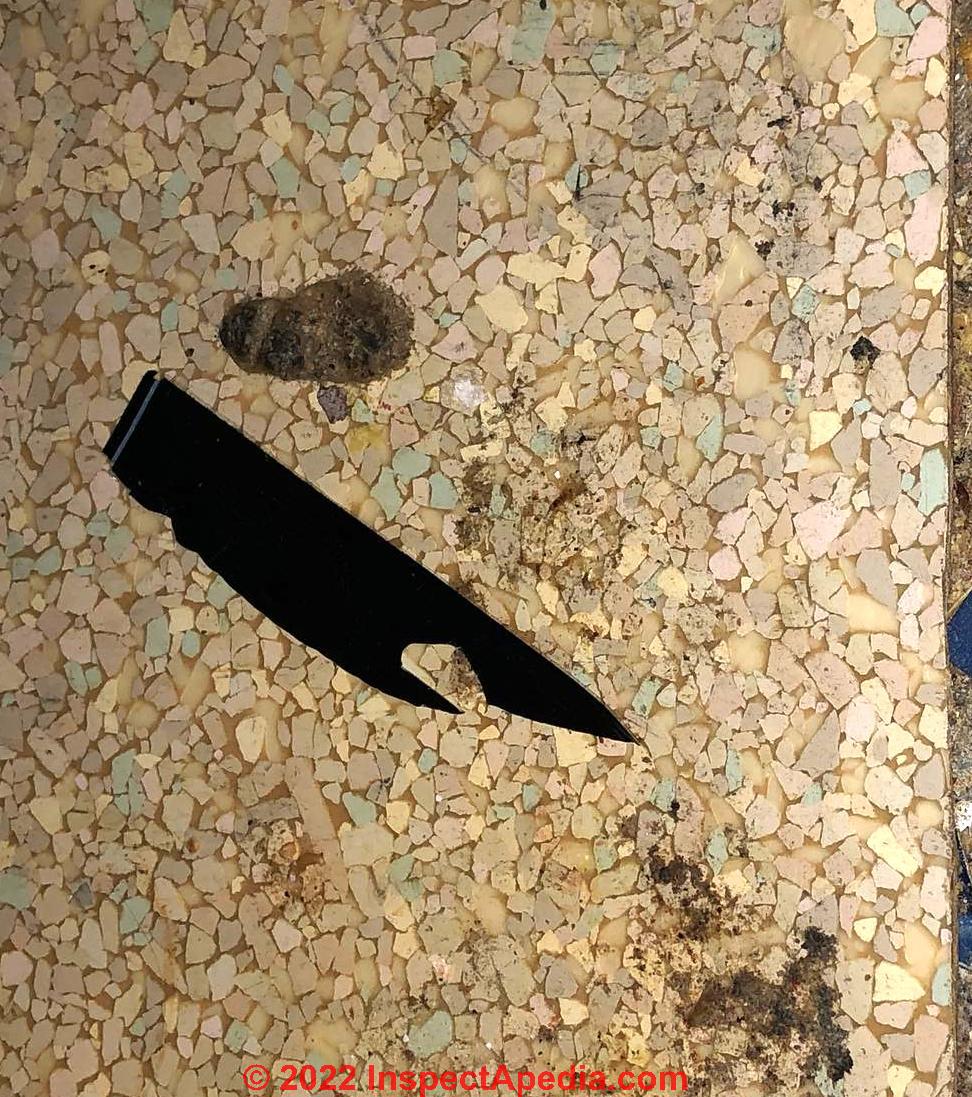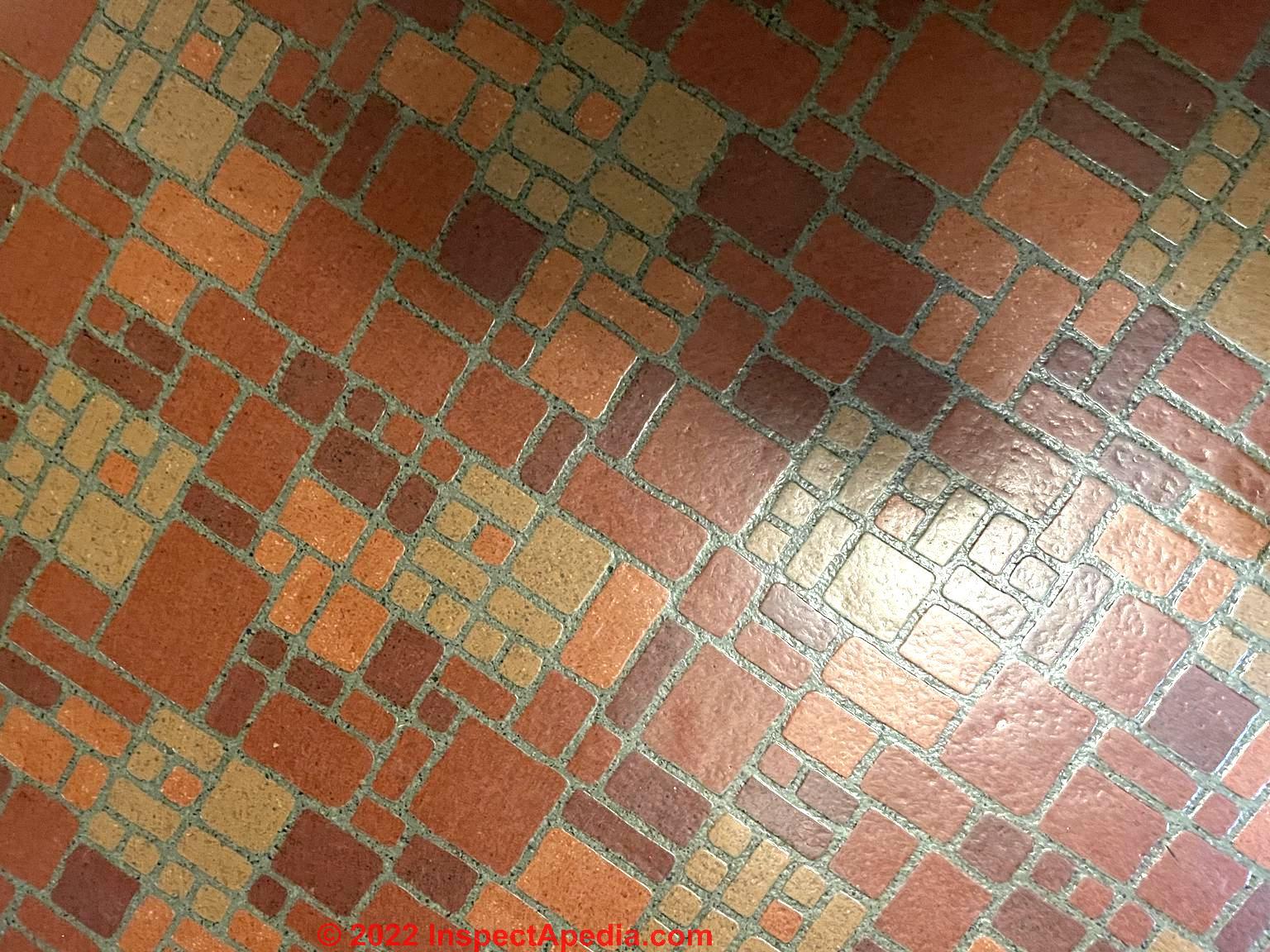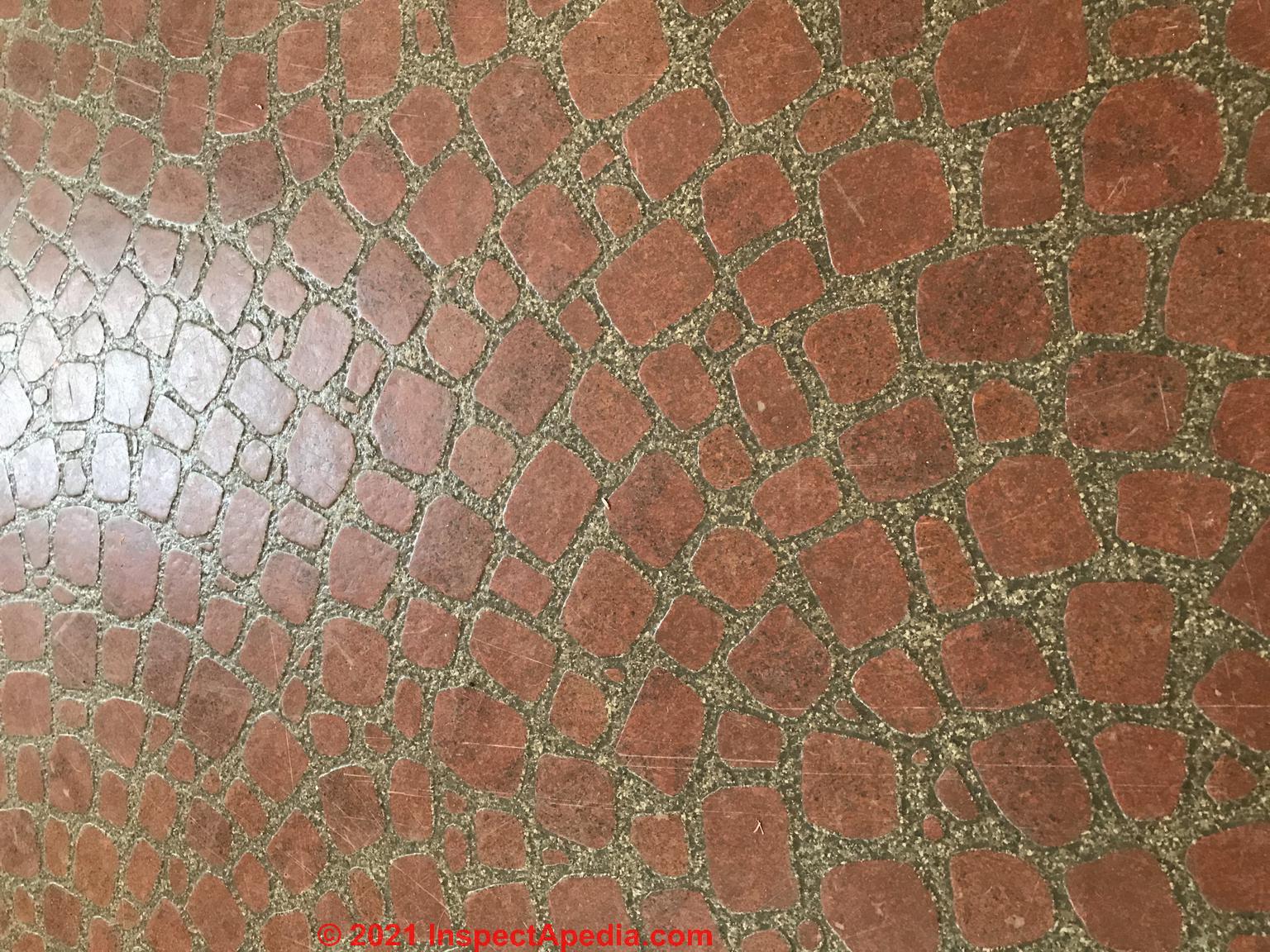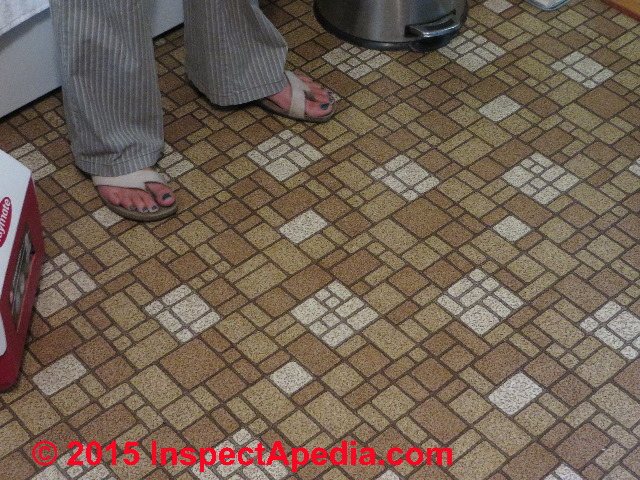 Resilient Flooring or Sheet Flooring that Might Contain Asbestos
Resilient Flooring or Sheet Flooring that Might Contain Asbestos
Sheet flooring 1920-1988 ID Photos & Requests
- POST a QUESTION or COMMENT about sheet flooring products that might contain asbestos
Possible-asbestos-containing sheet flooring or resilient flooring products from 1920 - 1988:
Here are identification photos & markings that help identify resilient sheet flooring made or installed up to 1988 and that may contain asbestos.
This article series describes sheet flooring products known to contain significant levels of asbestos. We describe sources of asbestos in older forms of sheet flooring including felt-backed flooring, rubber-backed flooring, and vinyl cushion-backed resilient flooring products.
We also include photographs for identification of known asbestos-containing resilient sheet flooring as well as unknown flooring submitted for identification. The article gives safety and asbesto s testing advice for sheet flooring products.
InspectAPedia tolerates no conflicts of interest. We have no relationship with advertisers, products, or services discussed at this website.
- Daniel Friedman, Publisher/Editor/Author - See WHO ARE WE?
Examples & Submissions of Pre-1988 Installations of Sheet Flooring & Resilient Flooring that Might Contain Asbestos
If you ask about the chances of asbestos in a flooring product without being able to give its country and probable date range or at least the age of the building, then first sure to get the easy help given at
DOES THIS FLOOR CONTAIN ASBESTOS? - 5 easy questions to tell if your FLOOR probably contains asbestos
Asbestos-suspect 1984-1985 Armstrong vinyl sheet flooring in New Zealand
Example reader question: Could anyone tell me if this flooring is asbestos?
House built: 1984-1985
Country: New Zealand
Sheet not tiles.
White middle and backed.
The small piece removed from the concrete floor (for the picture of backing) came up easily, didnt need to heat or scrape it, did not leave any backing paper of any kind on the concrete, nor glue that i could see.
This needs to come up as water under it due to a pipe bursting. Regards, Liz - On 2019-10-26 by Liz -
HiYa, Can anyone identify if this is asbsetos sheet Flooring, from Armstrong, No paper backing left on floor at all, just pulls straight off the concrete floor without heat or scraping. I have looked through and can not see this pattern displayed anywhere.
House Built in 1984-1985. Country: New Zealand
Reply by (mod) - Asbestos-suspect 1984-1985 Armstrong vinyl sheet flooring in New Zealand
Liz
See your question and our detailed reply now
at ASBESTOS FLOORING IDENTIFICATION 1950's or LATER in New Zealand
Amstrong did produce sheet flooring in similar patterns that did contain asbestos but of course one can't be certain without an actual test.
DOES THIS FLOORING CONTAIN ASBESTOS?
will be helpful for you
Identify Older Linoleum Rug Pattern or Black-Asphalt-Backed Sheet Flooring
The flooring above and below produced on a black substrate (asphalt impregnated felt paper) is asphalt-felt backed linoleum; similar products, typically by Congoleum may have a red or green backing and sometimes a rubber backing that is not an asbestos material.
Backer types are identified separately
at VINYL SHEET FLOORING BACKER TYPES.
Watch out: some asphalt-impregnated felt products used in roofing, siding, and flooring contained asbestos.
The sheet flooring shown above in two views was installed in a home in northern Minnesota, dates from the 1960's to 1970's.
I would treat this floor as "PACM" - Presumed Asbestos-Containing Material because our own test of samples of this floor confirmed presence of chrysotile asbestos.
Complete details about the sheet flooring pattern shown above can be read
at MARBLE / STONE CHIP PATTERN FLOORING ASBESTOS
The sheet flooring shown above at left was installed in a home in Hyde Park, NY and (we think) dates from the 1970's. This popular pattern was widely used. I would treat this floor as "PACM" - Presumed Asbestos-Containing Material.
More about the floor pattern shown above (popular since 1932) is found
at SHEET & TILE FLOORING ASBESTOS ID-BRICK PATTERN ID
Above the photo is of sheet flooring of which a reader opined that the stone-rectangle flooring dated from the 1970's - a basis for treating the floor as "PACM". To me the floor looked much newer.
Asbestos confirmed in backer of sheet flooring shown above
Our reader confirmed that the 1970's sheet flooring shown above and located in a Kansas home (U.S.) was tested and found to contain more than 1% asbestos in the flooring backing. 2017/03/28 - private email to editor
The flooring sample, tested by ACT, a Kansas asbestos testing laboratory, was found to contain 65% Chrysotile asbestos in its off-white compact fibrous backing.
Adhesive was not found in the flooring adhesive nor in the flooring's top layer that provides a clear wear-surface and the flooring's color-pattern.
Reader Question: Is this rug-pattern floor covering asbestos tile or sheet flooring Linoleum?
I wanted to seek your advice on the attached images which is some sort of tiling that a previous homeowner put on a work bench as a covering. I looked through your website, but couldn't find a match. Does this look like asbestos tiles to you? If so, any idea on the brand? Thanks in advance! - C.W. 1/17/2014
[Shown in the two photographs above - click to enlarge any image]
Reply: forms of "linoleum" may include products glued to felt underlayment vs. glued to a jute backing
From your photographs showing that the flooring product, now covering a workbench top, has a woven rug -patterned top layer over a black substrate, I would guess that this is an asphalt paper-backed sheet flooring product resembling
but not using the traditional or pure linoleum ingredients nor using linoleum's jute fabric backing.
In that article we discuss your photographs in more detail and there we explain that the ingredients of true linoleum include natural resins, linseed oil, color pigments, cork powder and limestone, with a jute backing. Those products do not contain and never contained asbestos.
But there, in a more detailed reply to your inquiry, we also explain that some sources, including experts at the US FPL describe felt or asphalt-backed sheet flooring as "linoleum" - products like that shown in your photos. At least some of these older felt underlayments contained asbestos.
Reader Question: Not sure if these contain asbestos or not. Rug pattern sheet flooring with green backing
They are old - the kind that last a long time! The fleck type one was under several layers of flooring in my grandparents home. I think they built it around 1935.
The second one, [shown immediately above] the rug pattern is the one I am most interested in finding out about. The backing is green but I cannot find a makers mark on it. Any idea if that means anything? - Anon [by private email] 23 Aug 2015
Reply:
The photo shown just above looks like a rug pattern linoleum and if the green rolled material in the right of your photo is the same flooring, it is more likely a Congoleum (or less likely Armstrong) sheet flooring product. Some Congoleum sheet flooring included a red or possibly green rubber backing that is not an asbestos material.
Armstrong, Congoleum, Linoleum sheet flooring is also discussed
IF you are faced with a requirement for demolition and if you are uncertain about the flooring's asbestos content and cannot identify it through our guides, then you have a sample tested.
See ASBESTOS TESTING LAB LIST and as it will help other readers, if you have this flooring tested please confirm the lab result with us and send me a copy of the lab report.
Identify Older Armstrong Sheet Flooring that Might Contain Asbestos: check the backing material
Reader Question: does this old Armstrong brand sheet flooring contain asbestos?
Hi - I'm so happy to have found your site. I would so appreciate your help identifying the Armstrong sheet flooring (photos attached) in our 140 year old house.
Weirdly (at least to me), this flooring was laid directly on top of the sub-floor. I do not know why the original hardwood is missing, if in fact it ever existed (our little town has a history of flooding, so perhaps it was damaged and removed). We discovered this flooring when we pulled up the carpet.
We were hoping to find the original hardwood, but found this Armstrong sheet flooring over the subfloor instead.
Of course, our concern is that the flooring or the fibrous paper backing may contain asbestos. We're diy-ers, but don't want to take unnecessary risk if it does contain asbestos. Thank you so much!!! - L.T. 1/6/2014Reply: a quick review distinguishing linoleum from vinyl sheet flooring
Your first two photos show what looks to me like Armstrong sheet vinyl flooring in a woven, fabric, or carpet pattern. The backing of your flooring product (above right) is not jute (a coarse brown fabric) and is not asphalt felt (a black thick paper like product impregnated with asphalt).
Rather I see a white or light colored backer. Some white sheet flooring backers contained asbestos.
Indeed adding to the confusion of identifying traditional-formula true linoleum is that many people just call all flexible resilient sheet flooring "linoleum". Armstrong corporation, itself a long-time flooring manufacturer produced floor tiles, self adhesive floor tiles, and sheet flooring that the company identifies as linoleum as well as separate products that are identified as vinyl sheet flooring.
Linoleum: is made from linseed oil, resins, recycled wood flour, cork dust, limestone & mineral pigments. A quick and reliable way to identify linoleum is to observe that the walk-on surface is mounted on jute backing. On the under-side of linoleum you'll see a coarse brown fabric (jute) that looks like what some folks call "burlap".
Details are at LINOLEUM & SHEET FLOORING
Vinyl sheet flooring is made from plastic-like materials. Vinyl is a synthetic resin made of polyvinyl chloride or similar chemical polymers (originating typically as univalent chemical radical CH2CH, derived from ethylene and fabricated into a very large range of products besides flooring, such as vinyl phonograph records, windows, building siding, containers, etc. Details are in this article
at VINYL ASBESTOS SHEET FLOORING
In sum, your two photographs of Armstrong sheet flooring shown above include both the clearly-marked Armstrong brand on the flooring underside and a view of the white backing material characteristic of vinyl sheet flooring.
The pattern of the exposed surface of the flooring is an older-style that I have not yet found in various product catalogs but one that from appearance I would guess could be more than 30 years old.
Advice for Handling this Flooring
Without knowing anything more about your floor covering, it would be prudent to treat this material as "PACM" or "Presumed Asbestos Containing Material" given its appearance, age, and lack of product specifics.
(Sometimes we have success sending a flooring photo to Armstrong for identification.) If we knew when this sheet floor covering had been installed we'd be able to make a good guess about the chances that it contains asbestos - or not.
Otherwise a lab test or confirmation from Armstrong would be required.
Typically sheet flooring that has not been glued to a subfloor can be simply rolled-up. You may have to remove edge trim strips to gain access to the material. Where the flooring is damaged you'll want to see the suggested articles below and certainly avoid using a vacuum cleaner unless it's a HEPA-rated unit.
If you were facing a costly dusty messy renovation that means following the dust control and asbestos risk reduction advice from expert sources. See
- ASBESTOS FLOORING HAZARD REDUCTION
- ASBESTOS FLOOR TILE IDENTIFICATION COLOR KEY - home
- ASBESTOS FLOORING IDENTIFICATION GUIDE INDEX - all brands, all years
- ASBESTOS FLOORING REMOVAL GUIDE
From your second pair of photos (shown below) the composition of your flooring could be confusing. What I see looks like a pine subfloor over which masonite-type hardboard may have been installed as a smoothing underlayment (to prevent telegraphing the original lines of subfloor up through the sheet floor covering).
Indeed I doubt that your home is missing a hardwood floor. In many homes sheet flooring, at least in many rooms linoleum was installed directly atop the tongue-in-groove pine subfloor.
Reader Question: how to identify resilient sheet flooring - does this resilient flooring contain asbestos? how can I identify its brand or manufacturer? - Tests confirmed Asbestos content for this sheet floor product
I recently purchased a 180 year old home and found some mystery resilient flooring under two layers of linoleum. We have sent off samples for asbestos testing but I am also interested in figuring out the vintage of floor.
Would you be able to provide your expertise in possibly identifying this product?
I have been through your pictures and wonderfully helpful ID guide but just can't seem to make a positive identification, even of brand.
We have not yet seen any identifying marks on the product either. I thought at first that it might be an Armstrong spatter
Your help would be much appreciated - I am researching the history of the neighborhood.
Figuring out when the first major kitchen renovation happened in this house would really help to complete some of that research. I'm also just incredibly interested in finding out what it is now that I've done so much research on the history of floor coverings!
If you are willing to help, here are the vital stats:
The product is in sheet form, with a width of of 72.5 inches. It goes the entire length of the kitchen floor (at least 14 feet) so must have been laid from a larger roll.
It has a black paper-like backing and sticky, tar-like adhesive. I have attached pictures.
Thank you very much and best wishes, L. P-F. 8/12/2013
Reply:
The article above as well the following two articles on resilient and sheet flooring
may be helpful to you. I will look through our library and will also publish your photos [above and left] and invite comments from other readers - keeping your identity private unless you ask otherwise.
The flooring in your photo looks like products I've seen dating from the 1970's and later. Some of these contain asbestos in the backer.
Based on the age of the home and the multiple of layers of flooring above the one about which you ask, I would treat the material as PACM (presumed asbestos containing material) until we identify it or you have a lab test result on the flooring's asbestos content.
Lab test results on the above flooring: no asbestos content.
We got our test results back and both the flooring and the backing were negative for asbestos. The results showed the flooring was 45% cellulose material and 55% non-fibrous material. The backing was 90% cellulose and 10% non-fibrous. Does this mean that the flooring is newer than we originally thought?
Probably but not necessarily for sure; certainly there have been some sheet floorings that did not contain asbestos. But from the combination of the lab results and your photo one would think the material is post 1986.
Reader Question: possible asbestos in vinyl sheet flooring from 1977
Photos above and below: top view of 1977-era sheet vinyl flooring.
I have a house that was built in 1977 - not the first owner. In late December, one the kitchen wall cabinets fell off the wall causing me to push up remodeling efforts.
The kitchen floor had to come up. It has an initial layer of, I believe, vinyl sheet flooring. A self adhering tile floor was laid over top in 1988 or 1989 my an interim owner. Don't know what it is.
There are not markings as to the manufacturer on either (the self sticking tile may have some but getting them removed from the first floor is difficult).
I only had one thought - get the kitchen back to normal quickly. So in preparing for new cabinets, I decided to remove the floor. Not until it was (almost) up - needed to get some adhesive off - did I go to the internet. There I found out about asbestos. A little(?) late.
Included are some pictures of the floor's first layer of vinyl. Is it possible to tell me if it contains asbestos? I don't want to dump the floor inappropriately or subject my friends to "bad" air. - J.N. 1/10/2014
Reply:
J.N. Given the age of the home and its initial vinyl sheet flooring as well as the presence of a light-colored vinyl backing shown in your edge view of this material, it would be reasonable to treat the flooring as PACM - Presumed Asbestos Containing Material.
I've posted your photos in case other readers can name the specific decorative pattern while we research the image further
. I'm guessing this is an Armstrong vinyl sheet flooring product. The backer has been tested on some of that product line and confirmed as asbestos-containing from flooring of the age you indicate.
At
ARMSTRONG FLOOR TILE IDENTIFICATION 1974-1979
you will see some flooring patterns that are not identical but quite similar to your photographs.
Usually sheet flooring is easily removed intact and is not a source of significant particulate debris as long as it is not ground, sanded, or similarly damaged.
But to be extra careful you may want to follow asbestos flooring wetting - removal guidelines and to use a HEPA vacuum for jobsite cleanup. If you were facing a costly renovation or cleanup of a mess someone already made it might be cost-justified to have a certified asbestos testing lab test the material.
The disposal of removed vinyl flooring that may contain asbestos is regulated as asbestos-waste in some jurisdictions while I have found that in others the material is disposed-of as construction debris. Check with your local building department.
Reader Question: sheet flooring identification for possible asbestos content?
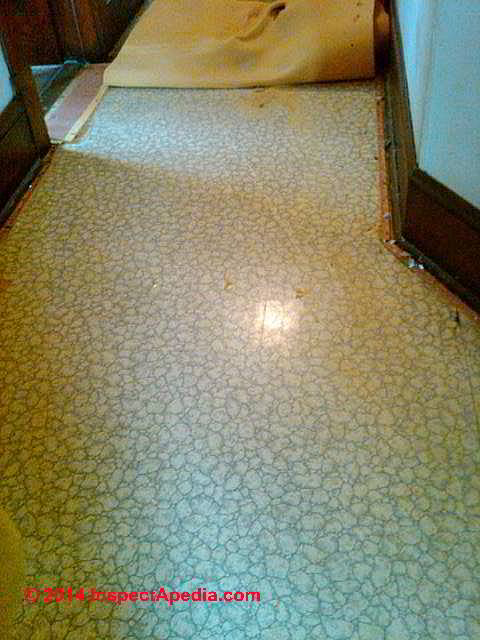 It does not exactly match any of your photos. We do not want to pull up a piece, so we don't know what brand it is or what the backing looks like.
It does not exactly match any of your photos. We do not want to pull up a piece, so we don't know what brand it is or what the backing looks like.
Is the flooring in the photo attached an asbestos-containing floor?
[We found this when removing flooring in an older home. We don't want to pull the flooring up so we don't know if it has markings on its back or not. ] - D.M. 7/28/2014
Reply:
I've not see this exact pattern but it's similar to some 1970's patterns that did contain asbestos. It would be prudent to assume the flooring contains asbestos.
If you are able to leave it in place and cover it the risk of asbestos release is most likely below the limits of detection. If it must be removed and can be removed in one piece (not glued down) risks are similarly small.
See these InspectApedia articles
ASBESTOS FLOORING HAZARD REDUCTION
and
ASBESTOS FLOORING REMOVAL GUIDE
if flooring removal is needed.
Reader follow-up:
It does resemble the Armstrong pebble pattern on your website. It was glued down at the entrances to the doors but does not seem to be glued all over. An electrician was working in the house and made a hole through the entire floor, which is how we first discovered this flooring under the carpet. Other than that spot and one missing chunk at a doorway, it is completely intact.
We had planned to peel it off using hot water and sand the floors. We have done that with 1980s era vinyl tile, but have not attempted any removal of older flooring.
Finland Sheet Flooring Products that May Contain Asbestos
The discussion of Finland or Finnish flooring that may contain asbestos has moved
to FINLAND VINYL SHEET FLOORING POSSIBLE ASBESTOS - separate article.
Swedish Flooring Products that May Contain Asbestos
This discussion has moved
to SWEDISH TARKETT FLOORING POSSIBLE ASBESTOS - separate article
Older sheet flooring that Does Not or is Unlikely to Contain Asbestos
This discussion has moved to SHEET FLOORING NON-ASBESTOS EXAMPLES - separate article. Shown above: traditional linoleum flooring.
...
Reader Comments, Questions & Answers About The Article Above
Below you will find questions and answers previously posted on this page at its page bottom reader comment box.
Reader Q&A - also see RECOMMENDED ARTICLES & FAQs
What is this black-backed sheet flooring in my 1947 EauClaire Wisconsin home?
I am having a room in my 1947 Eau Claire, WI home redone by a friend-- beneath the carpet was a relatively soft cracked flooring with what appeared to be a wood veneer. There was a soft black backing that almost looks paper like.
He asked if I wanted it up and since it was fairly easy to rip up, I said sure...only to question later if it had contained asbestos. There was a little adhesive beneath it, but it ripped up fairly easily. It isn't more than 1/16 in thick.
He said it didn't produce noticeable fibers with removal. I'm going to have it tested, but do you have any insight to maybe put me at ease? Thank you, A concerned mother
- On 2022-02-18 by Kris
Reply by Inspectapedia Com Moderator - Asphalt impregnated backer contained asbestos
@Kris,
Often the asphalt impregnated backer on older sheet flooring contained asbestos.
It's not friable if you're not grinding sewing chopping or otherwise making a dusty mess.
Does this marble chip sheet flooring contain asbestos?
Sorry if this is a duplicative post. Wondering if this pattern of sheet flooring contains asbestos. We just noticed that it was being used below kitchen sink on the bottom shelve that houses our kitchen garbage. House built in 1956 and don’t think the kitchen was ever updated.
Concerned that the exposed edge is releasing fibers every time there is movement with sliding garbage can back and forth, moving around cleaning products, etc. Thanks. - On 2021-06-29 by Matt
Reply by (mod) - chip pattern sheet flooring, 1960s often contains asbestos
Matt: Please see MARBLE / STONE CHIP PATTERN FLOORING ASBESTOS where we repeat and reply to your question.
Is there asbestos in this Armstrong sheet flooring in 1977 St. Paul, MN home
Armstrong sheet goods installed 1977 St. Paul Mn might it contain asbestos?
- On 2021-06-28 by Joel Bergstrom
Reply by Inspectapedia Com Moderator -
@Joel Bergstrom, In addition to the info on this page,
you will find details about the history of that flooring pattern and more examples of it at
SHEET & TILE FLOORING ASBESTOS ID-BRICK PATTERN ID
then you will want to look at the following article:
DOES THIS FLOORING CONTAIN ASBESTOS? - 5 easy steps that can help you make a reasonable guess at whether or not the floor you ask about contains asbestos.
https://inspectapedia.com/hazmat/DIY-Asbestos-Floor-Test.php
And if you determine it does contain asbestos, and if it is in good condition, the safest and least costly approach is to leave the flooring alone, in place, and to cover it with new material.
Is there asbestos flooring in my 1988-built house?
Hello my house was built in 88 and I removed the sheet floor without knowing the possibilities of asbestos. I used a glue remover and scrapped up all the paper and glue. I'm worried the paper backer has asbestos I can't see any brand on the bottom of the sheet covered in paper and glue here are some pictures thank you.
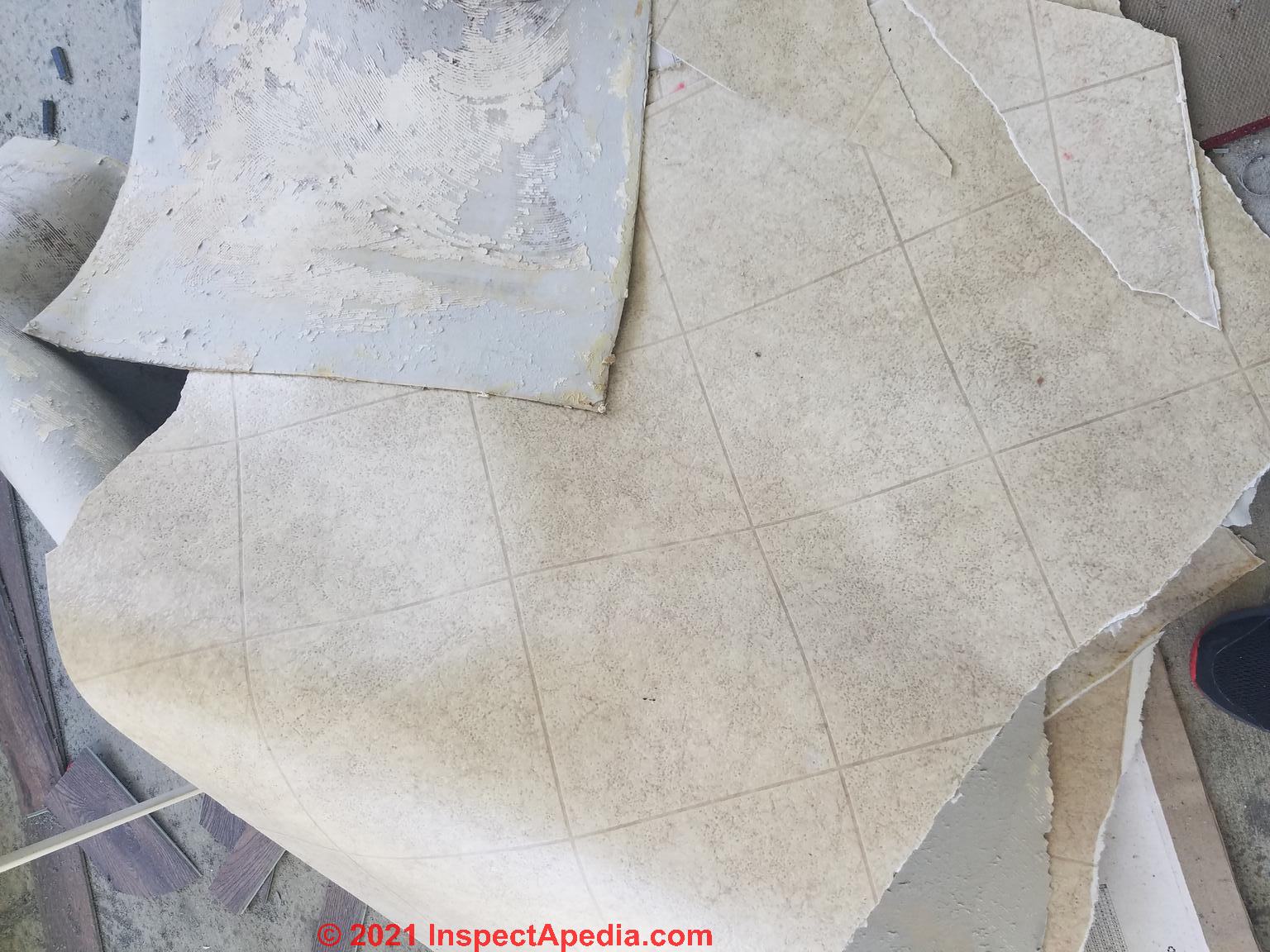
- On 2021-04-20 by David
Reply by (mod) -
@David,
You didn't mention the country and city of location of your home. If it's in the United States you should know that manufacturers start using asbestos in flooring products by 1986. So only if your flooring was made before the time would it be likely to contain asbestos.
Old flooring in a 1984 home: asbests?
I removed a layer of vinyl that had been installed in 2001 and found this underneath i was wondering if this could contain asbestos the house was built in 1984
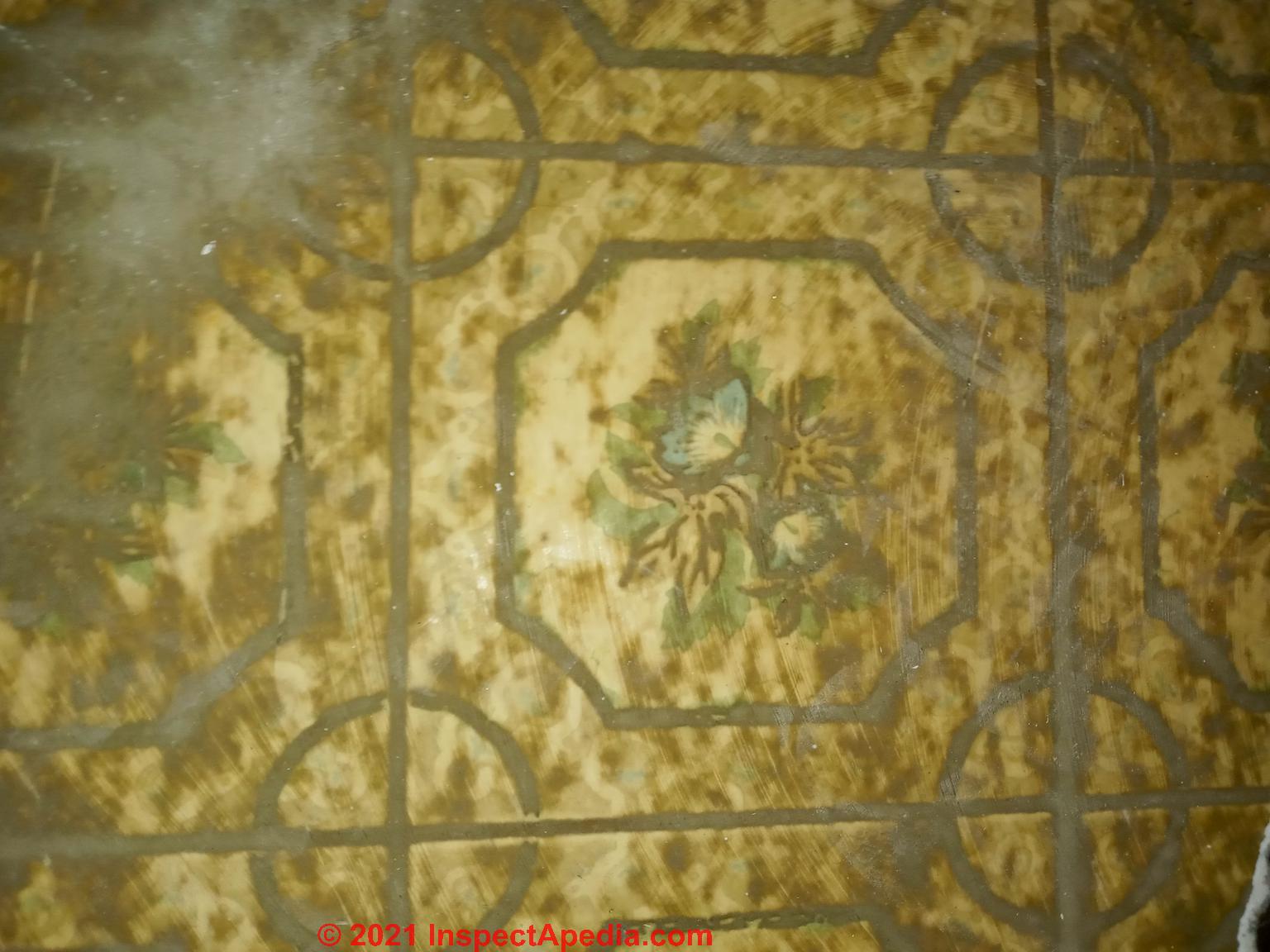
- On 2021-03-07 by Donnie
Reply by (mod) -
@Donnie, the easy questions found at
inspectapedia.com/hazmat/DIY-Asbestos-Floor-Test.php
DOES THIS FLOOR CONTAIN ASBESTOS?
can I help you make a reasonable guess which is about as much as you can do other than actually having a sample of the flooring tested for asbestos
Is this darly 1970's flooring anb asbestos product?
Is this sheet flooring pattern installed early 70s potential asbestos? Unsure of brand
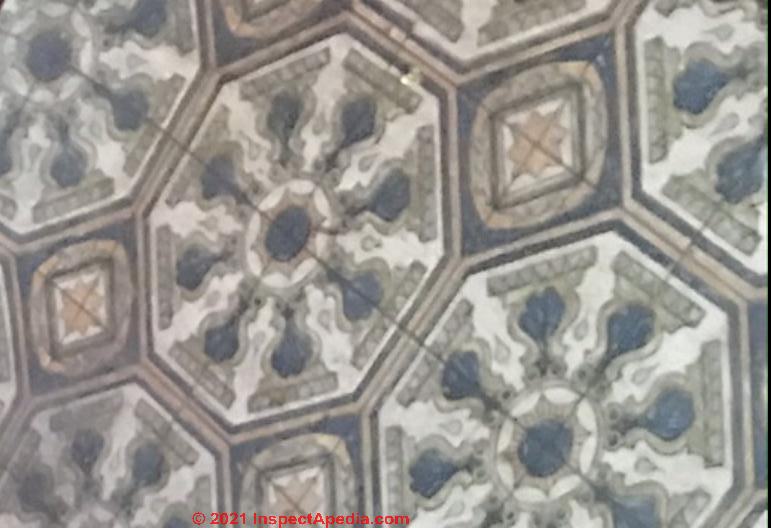
- On 2020-11-28 by marie
Reply by (mod) -
Marie
I don't recognize that exact flooring pattern but as you probably realize there are thousands of floor tile and sheet flooring patterns. In order to make a more confident guess about whether or not you're floor contains asbestos see if you can answer some of the easy questions found at
https://inspectapedia.com/hazmat/DIY-Asbestos-Floor-Test.php
DOES THIS FLOOR CONTAIN ASBESTOS?
Identify 1970 sheet flooring ina Main home and tell me if it contains asbestos
I am considering buying a house that was built in 1970 in Maine. It has the original kitchen flooring and I have attached an image.
Can you tell me if you if it's likely that it contains asbestos? And if so, is it best to remove it or go over it with a plank vinyl product? I am a single woman so would have to hire someone to do it.- On 2020-03-25 by Liz Hoffmann
Reply by (mod) - asbestos likely in 1970s red stone vinyl sheet flooring in Maine
Yes Liz that's a candidate floor for containing asbestos.
As long as the floor is in as good a shape as the section in your photo the asbestos-release hazard is very small - don't grind, chop, saw etc. the flooring. Best to simply cover it over with sheet vinyl or (more costly) a plank vinyl or laminate flooring.
See details at ASBESTOS FLOORING HAZARD REDUCTION https://inspectapedia.com/hazmat/Asbestos-Hazard-Reduction.phpWatch out: when buying a home, don't let your attention be so captured by something like fear of asbestos flooring that you miss more urgent, immediate life safety hazards such as an unsafe chimney or unsafe steps and railings. Be sure that you have an expert home inspection performed, and expect that inspector to give you an idea of priorities of attention for safety and of what costly repairs are in store for a new homeowner.
When would an owner install a new layer of sheet flooring in a home?
Hello.
My house has the pattern listed with the caption:
"The sheet flooring shown above at left was installed in a home in Hyde Park, NY and (we think) dates from the 1970's."
There's some conflicting issue here... The home was built in 1969, but the floor in question is installed over previous layer of sheet-floor.
So it's assumingly older than 1970, given it would be unlikely for the owner to install a floor directly over an existing sheet so soon after the build.
Does anyone have any futher information about this pattern? TIA -On 2018-01-21
by 70sStarterHome
Reply by (mod) -
Starter
It's not a "given" that an owner would not install a new layer of flooring directly over an existing one, even soon after the build, if the original floor suffered a mishap that left it damaged.
It's also possible that the popular pattern you have was sold over a greater number of years.
...
Continue reading at SHEET FLOORING INSPECT / TEST or select a topic from the closely-related articles below, or see the complete ARTICLE INDEX.
Or see these
Recommended Articles
If you are facing a large cost or have other reasons to be concerned about asbestos contamination in the building it would not be costly to have a small sample of the floor tested. The advice at the first four articles below should be helpful.
- ASBESTOS FLOORING HAZARD REDUCTION
- ASBESTOS FLOOR IDENTIFICATION - home
- ASBESTOS FLOORING REMOVAL GUIDE
- ASBESTOS TESTING LAB LIST
- DOES THIS FLOOR CONTAIN ASBESTOS? - 5 easy questions to tell if your FLOOR probably contains asbestos -
- IDENTIFY SHEET FLOORING TYPE
- POURED-IN-PLACE FLOORING, RESILIENT
- RESILIENT SHEET FLOORING ID GUIDE - home - various brands & countries
- SHEET FLOORING INSPECT / TEST
- SHEET FLOORING NON-ASBESTOS EXAMPLES
- SHEET FLOORING TYPE IDENTIFICATION
Suggested citation for this web page
SHEET FLOORING POSSIBLE ASBESTOS - 1920-1988 at InspectApedia.com - online encyclopedia of building & environmental inspection, testing, diagnosis, repair, & problem prevention advice.
Or see this
INDEX to RELATED ARTICLES: ARTICLE INDEX to ASBESTOS HAZARDS
Or use the SEARCH BOX found below to Ask a Question or Search InspectApedia
Ask a Question or Search InspectApedia
Try the search box just below, or if you prefer, post a question or comment in the Comments box below and we will respond promptly.
Search the InspectApedia website
Note: appearance of your Comment below may be delayed: if your comment contains an image, photograph, web link, or text that looks to the software as if it might be a web link, your posting will appear after it has been approved by a moderator. Apologies for the delay.
Only one image can be added per comment but you can post as many comments, and therefore images, as you like.
You will not receive a notification when a response to your question has been posted.
Please bookmark this page to make it easy for you to check back for our response.
IF above you see "Comment Form is loading comments..." then COMMENT BOX - countable.ca / bawkbox.com IS NOT WORKING.
In any case you are welcome to send an email directly to us at InspectApedia.com at editor@inspectApedia.com
We'll reply to you directly. Please help us help you by noting, in your email, the URL of the InspectApedia page where you wanted to comment.
Citations & References
In addition to any citations in the article above, a full list is available on request.
- Womble, Charlotte, "EC72-2015 A Resilieint Floor for Every Use, Taste, and Budget", [PDF] North Carolina Agricultural Extension Servcie, Raleighg NC USA, (May 1972), retrieved 2016/06/28 original source: http://digitalcommons.unl.edu/cgi/viewcontent.cgi?article=5436&context=extensionhist
- Richa Wilson, Kathleen Snodgrass, " EARLY 20TH-CENTURY BUILDING MATERIALS: RESILIENT FLOORING " [Very large PDF], Richa Wilson, Intermountain Regional Architectural Historian Kathleen Snodgrass, Project Leader, United States Department of Agriculture Forest Service, Technology & Development Program, August 2007, 7300-0773-2322-MTDC. Contact Kathie Snodgrass at MTDC: Tel: 406–329–3922, Email: ksnodgrass@fs.fed.us or Richa Wilson, author; USDA Forest Service, Intermountain Region, 324 25th Street, Ogden, UT 84401. Phone: 801–625–5704; fax: 801–625–5229: e-mail: rwilson@fs.fed.us
- Resilient Floor Covering Institute, 401 East Jefferson Street, Suite 102, Rockville, MD 20850, Tel: 301–340–8580, Website: http://www.rfci.com
- In addition to citations & references found in this article, see the research citations given at the end of the related articles found at our suggested
CONTINUE READING or RECOMMENDED ARTICLES.
- Carson, Dunlop & Associates Ltd., 120 Carlton Street Suite 407, Toronto ON M5A 4K2. Tel: (416) 964-9415 1-800-268-7070 Email: info@carsondunlop.com. Alan Carson is a past president of ASHI, the American Society of Home Inspectors.
Thanks to Alan Carson and Bob Dunlop, for permission for InspectAPedia to use text excerpts from The HOME REFERENCE BOOK - the Encyclopedia of Homes and to use illustrations from The ILLUSTRATED HOME .
Carson Dunlop Associates provides extensive home inspection education and report writing material. In gratitude we provide links to tsome Carson Dunlop Associates products and services.


